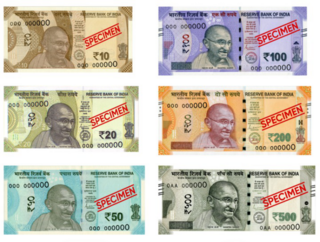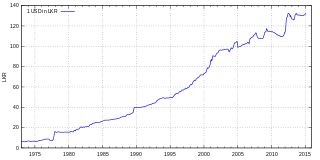
Rupee is the common name for the currencies of India, Mauritius, Nepal, Pakistan, Seychelles, and Sri Lanka, and of former currencies of Afghanistan, Bahrain, Kuwait, Oman, the United Arab Emirates, British East Africa, Burma, German East Africa, and Tibet. In Indonesia and the Maldives, the unit of currency is known as rupiah and rufiyaa respectively, cognates of the word rupee.
Legal tender is a form of money that courts of law are required to recognize as satisfactory payment for any monetary debt. Each jurisdiction determines what is legal tender, but essentially it is anything which when offered ("tendered") in payment of a debt extinguishes the debt. There is no obligation on the creditor to accept the tendered payment, but the act of tendering the payment in legal tender discharges the debt.

The Indian rupee is the official currency of India. The rupee is subdivided into 100 paise, though as of 2019, coins of denomination of 1 rupee are the lowest value in use. The issuance of the currency is controlled by the Reserve Bank of India. The Reserve Bank manages currency in India and derives its role in currency management on the basis of the Reserve Bank of India Act, 1934.

The Sri Lankan Rupee is the currency of Sri Lanka. It is subdivided into 100 cents, but cents are rarely seen in circulation due to its low value. It is issued by the Central Bank of Sri Lanka. The abbreviation Re (singular) and Rs (plural) is generally used, the World Bank suggests SL Rs as a fully disambiguating abbreviation for distinction from other currencies named "rupee".

The Pakistani rupee is the official currency of Pakistan since 1948. The coins and notes are issued and controlled by the central bank, namely State Bank of Pakistan.
Coins of the Indian rupee (INR) were first minted in 1950. New coins have been produced annually since then and they make up a valuable aspect of the Indian currency system. Today, circulating coins exist in denominations of One Rupee, Two Rupees, Five Rupees, Ten Rupees and Twenty Rupees. All of these are produced by four mints located across India, in Kolkata, Mumbai, Hyderabad, Noida.

An anna was a currency unit formerly used in British India, equal to 1⁄16 of a rupee. It was subdivided into four (old) Paisa or twelve pies. When the rupee was decimalised and subdivided into 100 (new) paise, one anna was therefore equivalent to 6.25 paise. The anna was demonetised as a currency unit when India decimalised its currency in 1957, followed by Pakistan in 1961. It was replaced by the 5-paise coin, which was itself discontinued in 1994 and demonetised in 2011. The term anna is frequently used to express a fraction of 1⁄16.

The escudo was the currency of Portuguese India between 1958 and 1961. It was subdivided into 100 centavos and was equal in value to the Portuguese escudo. After Portuguese India was annexed by the Republic of India in 1961, the escudo was replaced by the Indian rupee.

The history of the rupee traces back to ancient Indian subcontinent. The mention of rūpya by Pāṇini is seemingly the earliest reference in a text about coins. The term in Indian subcontinent was used for referring to a coin.
In 1820, in response to a request from the British colony of Mauritius, the imperial government in London struck silver coins in the denominations of 1⁄4, 1⁄8, and 1⁄16 dollars. The dollar unit in question was equivalent to the Spanish dollar and these fractional coins were known as 'Anchor Dollars' because of the anchor that appeared on them. More of these anchor dollars were struck in 1822 and not only for Mauritius but also for the British West Indies. In addition to this, a 1⁄2 dollar anchor coin was struck for Mauritius. A year or two later, copper dollar fractions were struck for Mauritius, the British West Indies, and Sierra Leone.
The rupee was the currency of Burma between 1852 and 1952, except for the years 1943–1945.

The rixdollar was the currency of British Ceylon until 1828. It was subdivided into 48 stivers, each of 4 duit. Units called the fanam and larin were also used, worth 4 and 9½ stiver, respectively. The currency derived from the Dutch rijksdaalder and stuiver, although the rijksdaalder was worth 50 stuiver.

The Hyderabadi Rupee was the currency of the Hyderabad State from 1918 to 1959. It coexisted with the Indian rupee from 1950. Like the Indian rupee, it was divided into 16 annas, each of 12 pai. Coins were issued in copper for denominations of 1 and 2 pai and ½ anna, in cupro-nickel for 1 anna and in silver for 2, 4 and 8 annas and 1 rupee.

The Travancore rupee was a type of currency issued by the erstwhile Indian princely state of Travancore, which was primarily located in the modern Indian state of Kerala. The rupee was largely a newer currency in comparison to the older currencies of Kerala such as the Fanams, Achus, Chuckrams as well as the Kasu. Its creation was probably intended for the increased trading with British India and the high-value transactions therein.
The fanam was a currency issued by the Madras Presidency until 1815. It circulated alongside the Indian rupee, also issued by the Presidency. The fanam was a small silver coin, subdivided into 80 copper cash, with the gold pagoda worth 42 fanams. The rupee was worth 12 fanams. After 1815, only coins of the rupee currency system were issued.
The dollar was the currency of Penang between 1786 and 1826. It was subdivided into 100 cents, also called pice, and was equal to the Spanish dollar. The dollar was introduced after the East India Company acquired the island in 1786. In 1826, the Indian rupee was declared legal tender in Penang at a value of 48 pice. The dollar again became the currency of Penang with the introduction of the Straits dollar.

The pagoda was a unit of currency, a coin made of gold or half-gold minted by Indian dynasties as well as the British, the French and the Dutch. It was subdivided into 42 fanams. The pagoda was issued by various dynasties in medieval southern India, including the Kadambas of Hangal, the Kadambas of Goa, and the Vijaynagar Empire.
The Indian rupee sign (₹) is the currency symbol for the Indian rupee, the official currency of India. Designed by D. Udaya Kumar, it was presented to the public by the Government of India on 15 July 2010, following its selection through an open competition among Indian residents. Before its adoption, the most commonly used symbols for the rupee were Rs, Re or, in texts in Indian languages, an appropriate abbreviation in the language used.

British trading posts in India were first established by the East India Company (EIC) early in the seventeenth century, which quickly evolved into larger colonies covering a significant part of the subcontinent. Early settlements or factories included Masulipatnam (1611) and Madras (1640) in the south, Surat (1612) in the west, and modern-day Kolkata (1698–99) in the east. These colonies gave rise to Madras Presidency, Bombay Presidency, and Bengal Presidency, and each Presidency had a separate coinage and monetary system. In time, the EIC adopted a unified system of coinage throughout all British possessions in India and the older Presidency system was discontinued. After the Indian Rebellion of 1857, control of EIC territories passed to the British Crown. Coinage issued after 1857 were under the authority of the monarch as India became part of the British Empire. With the Royal Titles Act 1876, Victoria took the title "Empress of India", so in 1877 coin inscriptions changed from Victoria Queen to Victoria Empress. There was a transition period after India gained independence on 15 August 1947, and the first set of republic India coins were issued in 1950.

The Indian 1-rupee coin (₹1) is an Indian coin worth one Indian rupee and is made up of a hundred paisas. Currently, one rupee coin is the smallest Indian coin in circulation. Since 1992, one Indian rupee coins are minted from stainless steel. Round in shape, the one rupee coins weighs 3.76 grams, has a diameter of 21.93-millimetre (0.863 in) and thickness of 1.45-millimetre (0.057 in). In independent India, one rupee coins was first minted in 1950 and is currently in circulation.













